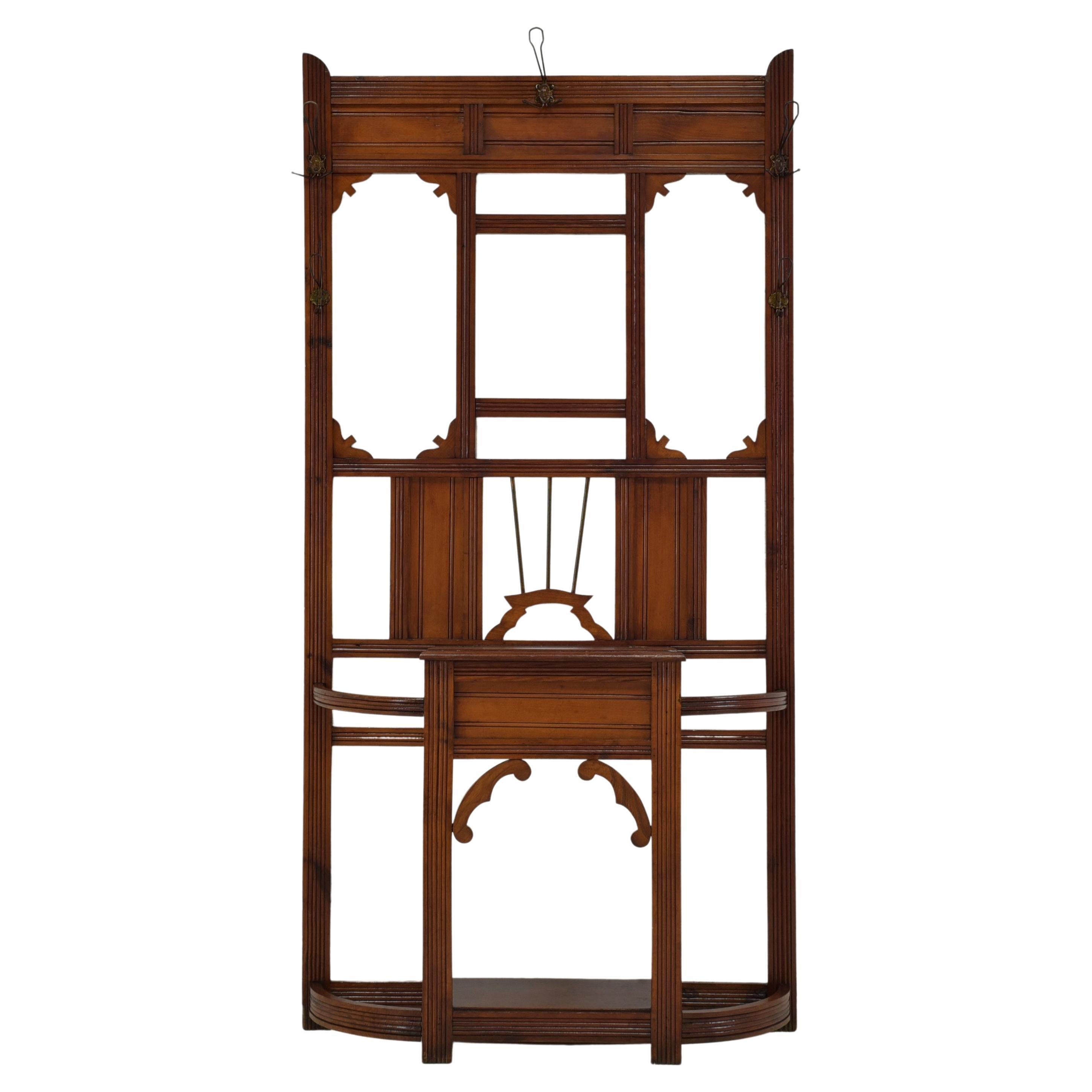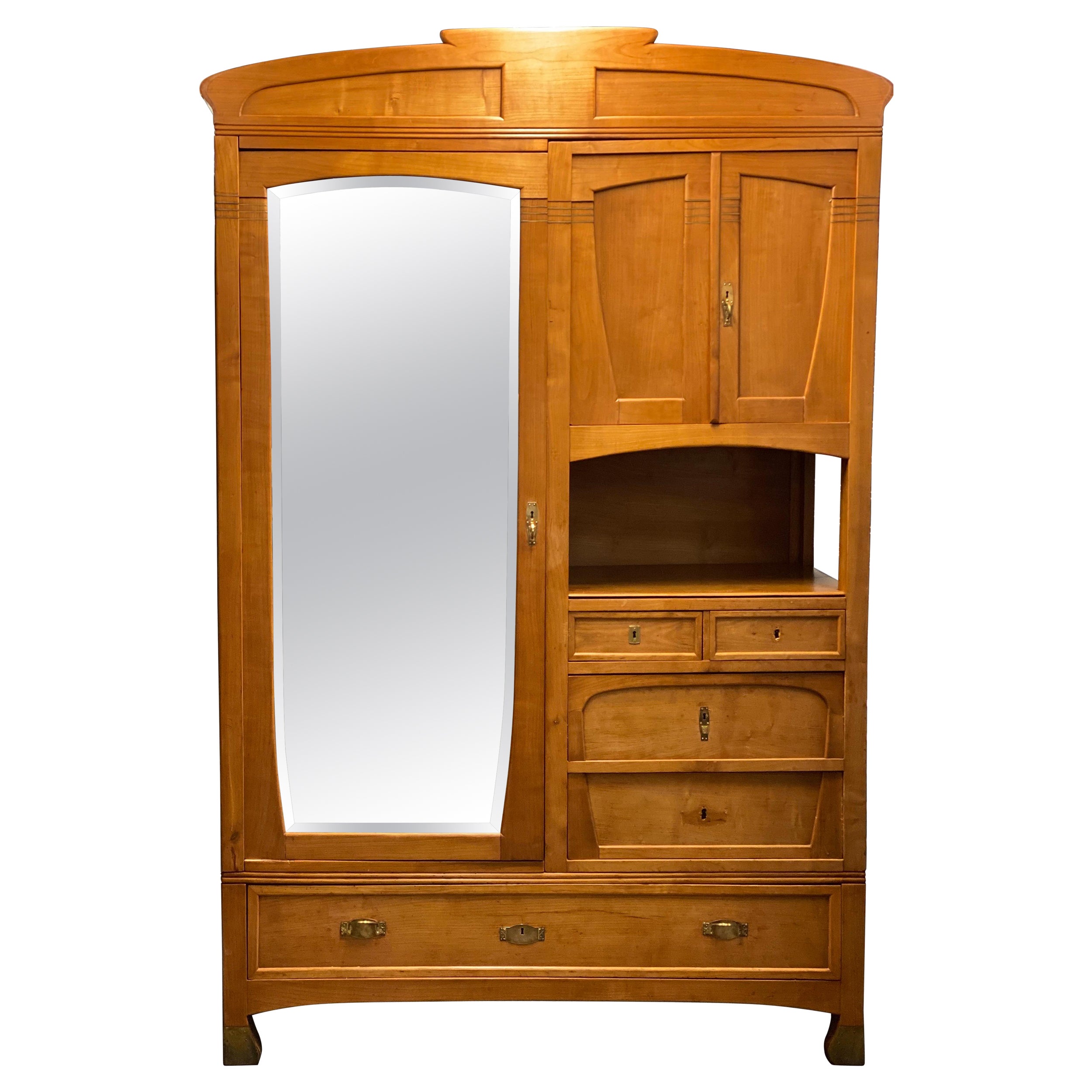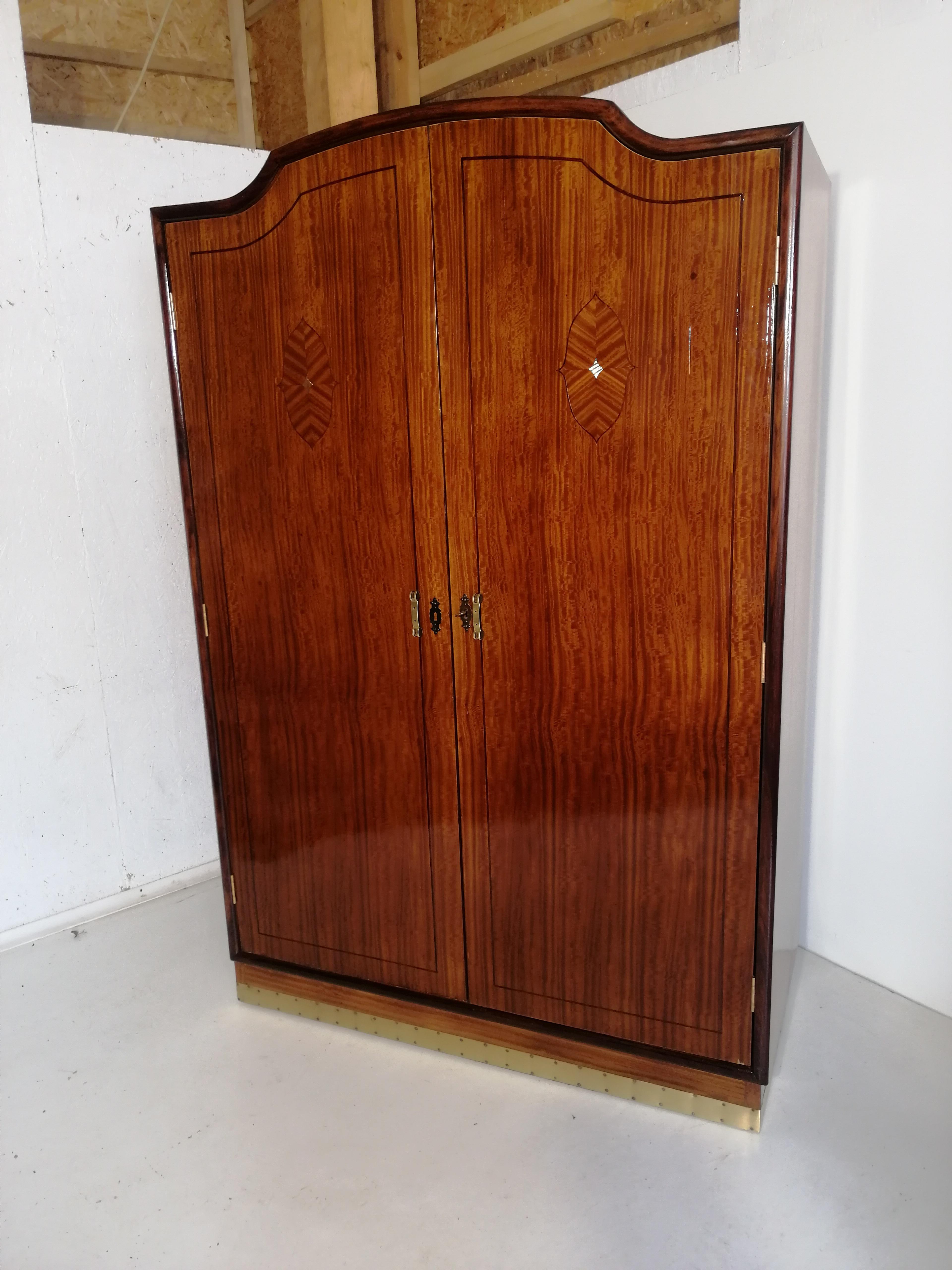Items Similar to Wardrobe by Colli Torino Est 1850 Art Nouveau Huge Italian Solid Oak Masterpiece
Want more images or videos?
Request additional images or videos from the seller
1 of 21
Wardrobe by Colli Torino Est 1850 Art Nouveau Huge Italian Solid Oak Masterpiece
About the Item
This wardrobe was produced by Colli Torino established in 1850.
- solid oak with hand-carved ornaments - beautiful brass fittings - with its original keys -
height: 195cms ~ width: 245cms ~ depth: 60cms ~ weight: ca. 360-400 Kg (!)
-: please have a closer look - which hopefully will make my fascination with this masterpiece comprehensible.
What also makes this wardrobe quite special is the 2 doors on each side covering compartments with narrow shelving boards - and the 2 compartments behind the 2 front doors in the middle with 3 bigger drawers in the upper section and 4 drawers in the lower sections which also are generously proportioned (all solid make with dovetail joints).
The 2 doors on the front side are fitted with mirrors inside and both compartments are provided with an upper clothes compartment and underneath you find brass hanger tubes.
The whole wardrobe is - of course - a demountable system.
In really excellent condition - ! -
____________________________________________________________________________________________
The company COLLI is well known because of Pier Luigi Colli (1895-1968) who also has been studying at the École des arts décoratifs in Paris who startet to reform the business by importing art deco lamps designed by Jean Perzel and glass objects of Lalique in his early years - later in the 1950s the iron furniture and mirrors were added in their portfolio.
The traditional furniture maker COLLI - which is known by only a few insiders - has produced artful luxury quality furniture at highest standards in their early days - especially around the turn of the century and the early 20th century in the Art Nouveau Era stunning pieces of furniture have been manufactured.
This set was part of a full set (you will find a matching bed set and a corner wardrobe on our other listings)
- Creator:Colli Torino (Cabinetmaker)
- Dimensions:Height: 76.78 in (195 cm)Width: 96.46 in (245 cm)Depth: 23.63 in (60 cm)
- Style:Art Nouveau (Of the Period)
- Materials and Techniques:
- Place of Origin:
- Period:1910-1919
- Date of Manufacture:circa 1915
- Condition:In excellent original condition.
- Seller Location:Kumhausen, DE
- Reference Number:1stDibs: LU8587233980252
About the Seller
5.0
Gold Seller
These expertly vetted sellers are highly rated and consistently exceed customer expectations.
1stDibs seller since 2023
9 sales on 1stDibs
Typical response time: 3 hours
- ShippingRetrieving quote...Ships From: Bodenkirchen , Germany
- Return PolicyA return for this item may be initiated within 10 days of delivery.
More From This SellerView All
- Colli Torino (Est. 1850) Art Nouveau Italian Corner Cabinet Wardrobe Solid OakBy Colli TorinoLocated in Kumhausen, DEThis corner wardrobe was produced by Colli Torino established in 1850. - solid oak with hand carved elements and beautiful brass fittings with its original key - The company is we...Category
Vintage 1910s Italian Art Nouveau Cupboards
MaterialsBrass
- Colli Torino 'Est. 1850 ' Italian Art Nouveau Bed & Nightstand Solid Oak carvedBy Colli TorinoLocated in Kumhausen, DEThis bed and night stand was produced by Colli Torino established in 1850. - solid oak with hand-carved elements - mattress size is 120cm x 190cm - The company is well known becau...Category
Vintage 1910s Italian Art Nouveau Beds and Bed Frames
MaterialsOak
- Bespoke Burl Wooden Art Nouveau Display Glass Cabinet H. Pössenbacher Est. 1784By Moritz BallinLocated in Kumhausen, DEA bespoke diplay cabinet made by one of Munich´s most traditional cabinet makers Heinrich Pössenbacher in the early 1900 years (between 1908 and 1918) The piece of furniture which is in incredibly good condition has been produced for a family in the Bogenhausen district of Munich and was part of set (a credenza 2 beside tables and a huge dining table with 6 chairs) which we´ve already sold. The tables and chairs are now in an apartment in Schloss Schönbrunn in Vienna - the huge credenza in a noble house in Zehlendorf / Berlin) This beauty which is still available is consisting of 2 pieces (upper display cabinet and base - both quite heavy ). Veneered with finest walnut burl wood - Intarsia works with classic Jugendstil ornaments - lower base and legs artfully surrounded by a wooden trim. These furniture are amongst the most beautiful and at highest standard artfully elaborated pieces I´ve ever have had the pleasure to own. The unbelievably good condition is no doubt due to the fact that the pieces virtually never have been used as since the early 1960s they were standing in the living room of a farmstead which belongs to the heir a family member of the original owners - covered with blankets all...Category
Vintage 1910s German Art Nouveau Vitrines
MaterialsBurl, Walnut, Wood, Glass
- art nouveau oak stool chair Jugendstil Rabenau embroidery a. 1910 exc conditionLocated in Kumhausen, DEsolid built oak Jugendstil CHAIR made in Rabenau / Saxonia upholstered with care - fitted with hand embroidered jute fabric Rabenau's chairmaking tradition is almost 400 years ol...Category
Vintage 1910s German Art Nouveau Chairs
MaterialsWool, Jute, Oak
- Art Nouveau Southern French Fayance art pottery FLOOR VASE rare colours&patternLocated in Kumhausen, DEA giving joy beautiful French Fayence Floor Vase fantastic Art Nouveau pattern - Impressing Colours Manufacturer unknown - marked Design Period 1915 - 1925 Country of Manufacture : France H / height: 46 cm ~ Gew. / weight: 4550 grs DM / diameter max: 28 cm ~ DM oben / diameter inner rim: 19.8 cm .... an ode to Southern France A Legend of Provence by Adelaide Anne Procter (30 October 1825 – 2 February 1864) The lights extinguished, by the hearth I leant, Half weary with a listless discontent. The flickering giant-shadows, gathering near, Closed round me with a dim and silent fear. All dull, all dark; save when the leaping flame, Glancing, lit up a Picture's ancient frame. Above the hearth it hung. Perhaps the night, My foolish tremors, or the gleaming light, Lent power to that Portrait dark and quaint, — A Portrait such as Rembrandt loved to paint, — The likeness of a Nun. I seemed to trace A world of sorrow in the patient face, In the thin hands folded across her breast: — Its own and the room's shadow hid the rest. I gazed and dreamed, and the dull embers stirred, Till an old legend that I once had heard Came back to me; linked to the mystic gloom Of that dark Picture in the ghostly room. In the far south, where clustering vines are hung; Where first the old chivalric lays were sung; Where earliest smiled that gracious child of France, Angel and knight and fairy, called Romance, I stood one day. The warm blue June was spread Upon the earth; blue summer overhead, Without a cloud to fleck its radiant glare, Without a breath to stir its sultry air. All still, all silent, save the sobbing rush Of rippling waves, that lapsed in silver hush Upon the beach; where, glittering towards the strand The purple Mediterranean kissed the land. All still, all peaceful; when a convent chime Broke on the mid-day silence for a time, Then trembling into quiet, seemed to cease, In deeper silence and more utter peace. So as I turned to gaze, where gleaming white, Half hid by shadowy trees from passers' sight, The Convent lay, one who had dwelt for long In that fair home of ancient tale and song, Who knew the story of each cave and hill, And every haunting fancy lingering still Within the land, spake thus to me, and told The Convent's treasured Legend, quaint and old: — Long years ago, a dense and flowering wood, Still more concealed where the white convent stood, Borne on its perfumed wings the title came: " Our Lady of the Hawthorns " is its name. Then did that bell, which still rings out to-day, Bid all the country rise, or eat, or pray. Before that convent shrine, the haughty knight Passed the lone vigil of his perilous fight; For humbler cottage strife or village brawl, The Abbess listened, prayed, and settled all. Young hearts that came, weighed down by love or wrong, Left her kind presence comforted and strong. Each passing pilgrim, and each beggar's right Was food, and rest, and shelter for the night. But, more than this, the Nuns could well impart The deepest mysteries of the healing art; Their store of herbs and simples was renowned, And held in wondering faith for miles around. Thus strife, love, sorrow, good and evil fate, Found help and blessing at the convent gate. Of all the nuns, no heart was half so light, No eyelids veiling glances half as bright, No step that glided with such noiseless feet, No face that looked so tender or so sweet, No voice that rose in choir so pure, so clear, No heart to all the others half so dear, So surely touched by others' pain or woe, (Guessing the grief her young life could not know,) No soul in childlike faith so undefiled, As Sister Angela's, the " Convent Child. " For thus they loved to call her. She had known No home, no love, no kindred, save their own. An orphan, to their tender nursing given, Child, plaything, pupil, now the Bride of Heaven And she it was who trimmed the lamp's red light That swung before the altar, day and night; Her hands it was whose patient skill could trace The finest broidery, weave the costliest lace; But most of all, her first and dearest care, The office she would never miss or share, Was every day to weave fresh garlands sweet, To place before the shrine at Mary's feet. Nature is bounteous in that region fair, For even winter has her blossoms there. Thus Angela loved to count each feast the best, By telling with what flowers the shrine was dressed. In pomp supreme the countless Roses passed, Battalion on battalion thronging fast, Each with a different banner, flaming bright, Damask, or striped, or crimson, pink, or white, Until they bowed before a newborn queen, And the pure virgin Lily rose serene. Though Angela always thought the Mother blest Must love the time of her own hawthorn best, Each evening through the years, with equal care, She placed her flowers; then kneeling down in prayer, As their faint perfume rose before the shrine, So rose her thoughts, as pure and as divine. She knelt until the shades grew dim without, Till one by one the altar lights...Category
Vintage 1910s French Art Nouveau Vases
MaterialsPottery
- straight huge baroque oak dome top chest ar. 1750 very heavy dovetail jointsLocated in Kumhausen, DE""~!~** STRAIGHT **~!~** Baroque round-lidded chest, also known as a dome top chest, solid oak, with heavy fittings, around 1750. The chest is in a "refined for the home condition...Category
Antique 1750s German Art Deco Blanket Chests
MaterialsWrought Iron
You May Also Like
- Art Nouveau / Art Deco Wardrobe in Oak, 1925Located in Lüdinghausen, DEWardrobe restored Art Nouveau / Art Deco around 1925 oak Features: Asymmetric model with mirror, hook and compartment with drawer Beautiful ornaments Very nice patina Additi...Category
20th Century Art Nouveau Wardrobes and Armoires
MaterialsOak
- Italian Art Nouveau Ash Armoire Wardrobe, c. 1900Located in Southampton, NYItalian Art Nouveau Ash Armoire Wardrobe, c. 1900 The Art Nouveau cabinet from circa 1900 thought to be made in Italy. The details show a refined restrained elegance reflecting the ...Category
Antique Early 1900s Italian Art Nouveau Wardrobes and Armoires
MaterialsBrass
- Art Nouveau Rosewood WardrobeLocated in Kraków, MałopolskaArt Nouveau rosewood wardrobe. Second wardrobe on my second auction. The furniture from our workshop is manually covered with high-gloss shellac Laquer.Category
Antique 1890s Polish Art Nouveau Wardrobes and Armoires
MaterialsWalnut
- Art Nouveau Rosewood WardrobeLocated in Kraków, MałopolskaArt Nouveau rosewood wardrobe. Second wardrobe on my second auction. The furniture from our workshop is manually covered with high-gloss shellac Laquer.Category
Antique 1890s Polish Art Nouveau Wardrobes and Armoires
MaterialsWalnut
- German Art Nouveau Oakwood WardrobeLocated in Darmstadt, DEVery beautiful small Art Nouveau wardrobe in oakwood with original hooks. The wardrobe has a big umbrella stand as well as six and two clothes hooks. The ...Category
Antique Early 1900s German Art Nouveau Wardrobes and Armoires
MaterialsTin
- German Art Nouveau Oakwood WardrobeLocated in Darmstadt, DEVery beautiful Art Nouveau wardrobe in oakwood with solid brass hooks. The wardrobe has a big umbrella stand as well as six clothes hooks. The wardrobe is...Category
Antique Early 1900s German Art Nouveau Wardrobes and Armoires
MaterialsBrass
Recently Viewed
View AllMore Ways To Browse
Used Traditional Furniture
Antique Traditional Furniture
Traditional Antique Furniture
Torino Italy
Antique Solid Oak Door
Antique Solid Oak Doors
Italian Furniture Wardrobe
Wardrobe Italy
Huge Carved
Oak Nouveau
Oak Art Nouveau
Mirrored Wardrobe
Used Mirrored Wardrobe
Used Wardrobe With Mirror
Hand Carved Wardrobe
Oak Armoires and Wardrobes
Used Fitted Wardrobe
Used Fitted Wardrobes





